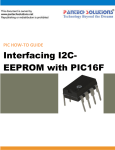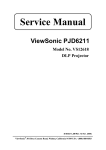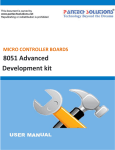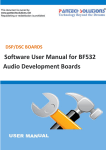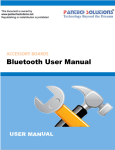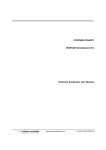Download Seven Segment Display
Transcript
PIC HOW-TO GUIDE
Interfacing 7SEG with
PIC16F877A
Contents at a Glance
PIC16F/18F Primer Board .................................................3
Seven Segment Display ....................................................3
Interfacing Seven Segment Display ..................................4
Interfacing Seven Segment with PIC16F877A....................5
Pin Assignment with PIC16F877A .....................................5
Circuit Diagram to Interface 7 segment with PIC16F877A .6
Source Code ....................................................................6
C Program to 7 Segment Display using PIC16F877A ..........7
Testing the I2C – Seven segment with PIC16F ................. 10
General Information ...................................................... 11
Join the Technical Community Today!
http://www.pantechsolutions.net
PIC16F/18F Primer Board
The PIC16F/18F Primer board is specifically designed to
help students to master the required skills in the area of
embedded systems. The kit is designed in such way that all
the possible features of the microcontroller will be easily
used by the students. The kit supports in system
programming (ISP) which is done through USB port.
Microchip’s PIC (PIC16F877A), PIC16F/18F Primer Kit is
proposed to smooth the progress of developing and
debugging of various designs encompassing of High speed
8-bit Microcontrollers.
Seven Segment Display
A seven segment display is the most basic electronic
display device that can display digits from 0-9. The most
common configuration has an array of eight LEDs arranged
in a special pattern to display these digits. They are laid out
as a squared-off figure ‘8’.
Join the Technical Community Today!
http://www.pantechsolutions.net
Interfacing Seven Segment Display
Fig. 1 shows how to interface the seven segments with
microcontroller. A seven segment is generally available in
ten pin package. While eight pins correspond to the eight
LEDs, the remaining two pins (at middle) are common and
internally
shorted.
These
segments
come
in
two
configurations, namely, Common cathode (CC)
and
Common anode (CA).
Fig. 1 Interfacing 7segment to Microcontroller
Join the Technical Community Today!
http://www.pantechsolutions.net
Interfacing Seven Segment with PIC16F877A
We now want to display a four digit number in
PIC16F/18F Primer Board by using seven segment displays.
The seven segment display is connected with PIC16F877A
microcontroller.
In PIC16f/18F Primer Kit, 4 nos. of common anode
seven segment displays are controlled by seven segment
drivers.
7-SEG Display
Pin Assignment with PIC16F877A
7-SEG Driver
PIC16F LINES
A
PORTB.0
B
C
D
E
F
PORTB.1
PORTB.2
PORTB.3
PORTB.4
PORTB.5
G
PORTB.6
DP
CL1
CL2
CL3
CL4
PORTB.7
PORTA.3
PORTA.2
PORTA.1
PORTA.0
Connections
* Connect PORTB with JP15 via FRC Cable.
* JP15 is at Seven Segment Section
Output
* Digits will be incrementing from 0 to 9999
Join the Technical Community Today!
http://www.pantechsolutions.net
MCLR
Circuit Diagram to Interface 7 segment with PIC16F877A
VDD
OSC2/CLKOUT
1
1
Q8
3
3
1K
2
3
1
3
330E R41 SEG4
330E R44 SEG5
330E R45 SEG6
330E R46 SEG7
7 SEG DISP
7 SEG DISP
SEG[0..7]
SEG[0..7]
7 SEG DISP
8
3
A
B
C
D
E
F
G
DP
7 SEG DISP
SEG[0..7]
7 SEGMENT DISPLAY
Source Code
The
Interfacing
seven
segment
displays
with
PIC16F877A program is very simple and straight forward,
which display a four digit number in seven segment display
.The C programs are developed in Mplab software. Here we
are increment a counter and display this value loaded into
seven segment driver in PIC16F/18F PIC Primer Board.
Join the Technical Community Today!
http://www.pantechsolutions.net
CA
SEG0 7
SEG1 6
SEG2 4
SEG3 2
SEG4 1
SEG5 9
SEG610
SEG7 5
CA
U8
8
3
A
B
C
D
E
F
G
DP
CA
A
B
C
D
E
F
G
DP
U7
SEG0 7
SEG1 6
SEG2 4
SEG3 2
SEG4 1
SEG5 9
SEG610
SEG7 5
CA
A
B
C
D
E
F
G
DP
U6
SEG0 7
SEG1 6
SEG2 4
SEG3 2
SEG4 1
SEG5 9
SEG610
SEG7 5
CA
330E R37 SEG2
SEG0 7
SEG1 6
SEG2 4
SEG3 2
SEG4 1
SEG5 9
SEG610
SEG7 5
8
U5
330E R29 SEG1
330E R40 SEG3
C50
R48
Q7
330E R28 SEG0
3
OSC1/CLKIN
SEG[0..7]
R47 1K
2
Q6
CA
Y14
10 Mhz
14
U14
CA
22pF
13
33
34
35
36
37
38
39
40
R22 1K
2
Q2
8
22pF
R21 1K
2
3
PIC16F877A
C51
RB0/INT
RB1
RB2
RB3/PGM
RB4
RB5
RB6/PGC
RB7/PGD
5
4
3
2
CA
RA3/AN3/Vref +
RA2/AN2/Vref RA1/AN1
RA0/AN0
1
12
31
VDD
VDD
VSS
VSS
1
MCLR/Vpp
U25
11
32
0.1uF
C52
C Program to 7 Segment Display using PIC16F877A
***************************************************************************************
Title : Program to Seven Segment display
***************************************************************************************
#include<pic.h>
// Define PIC Registers
_CONFIG(0x3f72); // HS,Enable(PWRTE,BOREN),
// Disable (CPD,CP,WDTEN,In-circuit Debugger)
#define CNTRL_PORT PORTA
#define DATA_PORT PORTB
void hex2dec(unsigned char);
void send_seg(unsigned char,unsigned char,
unsigned char,unsigned char);
void DelayMs(unsigned int);
unsigned char x;
unsigned char thou=0,hun=0,ten=0,single=0;
unsigned char CA[10]
=
{0xc0,0xf9,0xa4,0xb0,0x99,0x92,0x82,0xf8,0x80,0x90};
unsigned char CC[10]
=
{0x3f,0x06,0x5b,0x4f,0x66,0x6d,0x7d,0x07,0x7f,0x6f};
unsigned char CA_CNTRL[4]
unsigned char CC_CNTRL[4]
unsigned char n=1;
=
=
{0x07,0x0b,0x0d,0x0e};
{0x08,0x04,0x02,0x01};
void main()
{
unsigned char number;
nRBPU =0;
TRISB=0x00;
//PORTB configured as O/P
ADCON1=0x07;
//Configure PORTA & PORTE as Digital port
TRISA=0x00;
//PORTA Configured as O/P
Join the Technical Community Today!
http://www.pantechsolutions.net
while(1)
{
if(x == 200)
{
x=0;
single++; //Increment up to 9 in unit place
if(single>9)
{
single=0;
ten++; //Increment up to 9 in Tenth place
if(ten>9)
{
ten=0;
hun++;//Increment up to 9 in Hundredth place
if(hun>9)
{
hun=0;
thou++;//Increment up to 9 in Thousandth place
if(thou>9)
thou=0;
}
}
}
}
x++;
send_seg(thou,hun,ten,single);
}
}
void send_seg(unsigned char thou,unsigned char hun,
unsigned char ten,unsigned char single)
{
if(n==1)
{
Join the Technical Community Today!
http://www.pantechsolutions.net
CNTRL_PORT=CA_CNTRL[0]; //Eanble Unit place 7-Segment
DATA_PORT=CA[single];
//Display Unit Place Number
n=2;
DelayMs(5);
}
else if(n==2)
{
CNTRL_PORT=CA_CNTRL[1]; //Eanble Tenth place 7-Segment
DATA_PORT=CA[ten];
//Display Tenth Place Number
n=3;
DelayMs(5);
}
else if(n==3)
{
CNTRL_PORT=CA_CNTRL[2]; //Enable Hundredth place 7-Segment
DATA_PORT=CA[hun];
//Display Hundredth Place Number
n=4;
DelayMs(5);
}
else if(n==4)
{
CNTRL_PORT=CA_CNTRL[3];//Eanble Thousandth place 7-Segment
DATA_PORT=CA[thou];
//Display Thousandth Place Number
n=1;
DelayMs(5);
}
}
void DelayMs(unsigned int Ms)
{
int delay_cnst;
while(Ms>0)
{
Ms--;
for(delay_cnst = 0;delay_cnst <220;delay_cnst++);
}
}
Join the Technical Community Today!
http://www.pantechsolutions.net
To compile the above C code you must need the Mplab
software and Hi-Tech C Compiler. They must be properly set
up and a project with correct settings must be created in
order to compile the code. To compile the above code, the
C file must be added to the project.
In Mplab, you want to develop or debug the project
without any hardware setup. You must compile the code for
generating HEX file. In debugging Mode, you want to check
the port output without PIC16F/18F Primer Board.
The PICKIT2 software is used to download the hex file
into your microcontroller IC PIC16F877A through USB port.
Testing the I2C – Seven segment with PIC16F
Give +12V power supply to PIC16F/18F Primer Board;
the four seven segment display is connected with the
PIC16F/18F Primer Board. First check the entire seven
segments LED’s are properly working or not. Here we are
display just 1234 in four seven segment. The entire seven
segments receive it through I2C & display it in order.
Join the Technical Community Today!
http://www.pantechsolutions.net
If any data is not coming in seven segments, then you
just check the entire seven segments LED’s are working or
not. Change the seven segment driver IC & Check the I2C
connections. Check the four seven segments connections.
Otherwise you just check the code with debugging mode in
Mplab. If you want to see more details about debugging just
see the videos in below link.
How to create & Debug a Project in Mplab using
PIC16F using Hi-Tech Compiler.
General Information
For proper working use the components of exact values
as shown in Circuit file. Wherever possible use new
components.
Solder everything in a clean way. A major problem
arises due to improper soldering, solder jumps and
loose joints.
Use the exact value crystal shown in schematic.
Join the Technical Community Today!
http://www.pantechsolutions.net
More instructions are available in following articles,
Interfacing UART with PIC16F877A.
Interfacing Keys with PIC16F877A.
User Manual of PIC16F/18F Primer Board.
Create & Debug a project in Mplab using PIC16F877A.
Join the Technical Community Today!
http://www.pantechsolutions.net
Did you enjoy the read?
Pantech solutions creates information packed technical
documents like this one every month. And our website is a rich
and trusted resource used by a vibrant online community of
more than 1, 00,000 members from organization of all shapes
and sizes.
Join the Technical Community Today!
http://www.pantechsolutions.net
What do we sell?
Our products range from Various Microcontroller
development boards, DSP Boards, FPGA/CPLD boards,
Communication Kits, Power electronics, Basic electronics,
Robotics, Sensors, Electronic components and much more . Our
goal is to make finding the parts and information you need
easier and affordable so you can create awesome projects and
training from Basic to Cutting edge technology.
Join the Technical Community Today!
http://www.pantechsolutions.net














